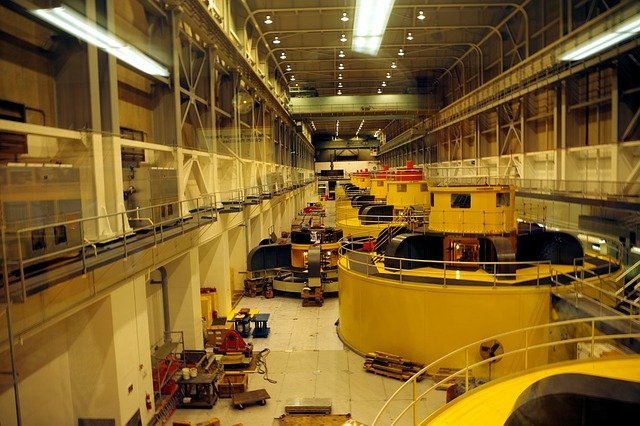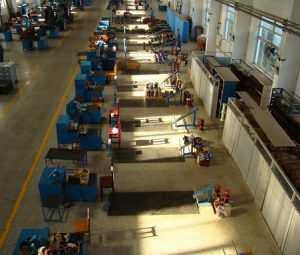Permanent magnet materials or hard magnetic materials are characterized by a high anisotropic field, high coercive force, large hysteresis loop area, and a high value of the magnetizing field for saturation magnetization. These materials retain Permanent magnets for a very long period even after the external magnetic field has been removed.

Types of permanent magnet materials
1.Ferrite
It’s one category of non-metallic magnetic material, also called magnetic ceramics. Open an ordinary radio, and we will see that its inner speaker magnet is ferrite.
Ferrite is a magnetically relatively weak material. Its maximum magnetic energy product is nowadays only a little above 4MGOe. However, the most important advantage of this material is its low price. Therefore, it finds wide application in many areas.
Ferrite is a ceramic material, so its workability is the same as that of ceramics. Ferrite magnets are molded and sintered. If they must be machined, they can only be superficially ground. Since it is tough to machine, most ferrite products have simple shapes and relatively large dimensional tolerances. The block-shaped products are in better condition and can be ground. Ring-shaped machines generally can only grind two planes. Other dimensional tolerances are given as a percentage of the nominal size.
Ferrite is widely used and inexpensive. Many manufacturers have a vast array of rings, squares, and other products in conventional shapes and sizes, that are ready-made for ferrite. Since ferrite is made of ceramic material, there is no corrosion problem. No electroplating or painting for surface treatment is needed with the finished product.
2. Rubber magnet
Rubber magnets are also a type of ferrite magnet and consist of bonded ferrite magnetic powder mixed with synthetic rubber. They can be processed by extrusion molding, calendering molding, and injection molding. The rubber magnets are flexible, elastic, and can be twisted, and they can be made in strips, rolls, sheets, blocks, rings, and many other forms.
Its magnetic energy product of 0.60 ~ 1.50 MGOe rubber magnetic material applications: refrigerators, message notice racks, fasteners to fix the object in the metal body to be used as advertising, and other fasteners. Can also be used for toys teachinginstrumentstswitchesch, and sensors of the magnetic sheet.
Rubber magnets are mainly used for micro motors, refrigerators, disinfection cabinets, kitchen cabinets, stationery, the advertisement industry, tries, etc.
3.Samarium cobalt
Magnetmagnet has samarium and cobalt as the major ingredients. As the price of both these base materials is very high, SmCo magnets also happen to be the most expensive among many types of magnets. Presently, the magnetic energy product of SmCo magnet reaches as high as 30MGOe, or even higher.
Besides, SmCo magnets have very high coercivity and good temperature resistibility; they may function in high temperatures of up to 350 degrees centigrade, and many uses substitute for them. The cobalt magnet can be regarded as one of the products called powder metallurgies. Usually, manufacturers sinter samarium cobalt magnets into square blanks depending on the size and shape required for the finished product, and then diamond blades saw them to the finished size. Since samarium cobalt is electrically conductive, it can be wire cut.
In theory, if it were not concerned with magnetization and larger sizes, the samarium cobalt could be cut into shapes that wire cutting can cut. Samarium Cobalt magnets have very good corrosion resistance and generally do not require anti-corrosion plating or painting. Moreover, the samarium cobalt magnet is very fragile, and it is not easy to process small sizes or thin-walled products.
4.Neodymium iron boron (NdFeB)
NdFeB is a widely used and rapidly developing magnet product. Due to its high magnetic property and easy processing, NdFeB does not have a very high price and thus has an expanding application field, although it was invented and put into application more than 20 years ago.
At present, the magnetic energy area of commercialized NdFeB can reach 50MGOe, which is 10 times that of ferrite. NdFeB also belongs to powder metallurgy products, and the processing method is similar to samarium cobalt.
The working temperature of NdFeB is about 180 degrees Celsius. It is generally not recommended to exceed 140 degrees Celsius for harsh environment applications. NdFeB is very easy to corrode, so most finished products are plated or coated.
The conventional surface treatments for NdFeB include: nickel plating, zinc plating, aluminum plating, electrophoresis, and so on. If it works in a closed environment, it can also be phosphatized. Because of the high magnetic properties of NdFeB, many applications use it to replace other magnetic materials to reduce the size of the product. Today’s cell phones would have been no smaller than half a brick if a ferrite magnet was used in its parts manufacturing.
Both of the magnets, the samarium cobalt magnet, and neodymium iron boron magnet, are of good machinability. Thus, the dimension tolerance of the products is much better than that of ferrite. In general, size tolerance can be (+/-)0.05mm.
5.Aluminum-nickel-cobalt(AlNiCo)
Alnico magnets have two processes: casting and sintering. While in China, casted Alnico magnet is more common. Alnico magnet has a magnetic energy product of up to 9 MGOe. The best feature of the motor is its temperature stability. The Alnico magnets are heat-resistant and can still work properly at temperatures up to 550° Celsius. However, Alnico is inclined to demagnetize in reverse magnetic fields. If the same poles of two Alnico are pushed together, one of the magnets’ magnetic fields will be demagnetized or reversed. Hence, it is not fit to work in a reverse magnetic field like electric motors.

Alnico is so hard that it can be ground and wire cut but at a higher cost. The general finished product is either well-ground or unground. Alnico is more widely used in the sensor field.
Main Properties of Permanent Magnetic Materials
1. residual magnetic field density
When the permanent magnet material in the external magnetic field reaches saturation, the value of magnetic induction strength of permanent magnet material is related to the magnetic density of the air gap in the motor, when the external magnetic field is zero. The larger the value of magnetic induction intensity is, the larger the air gap density of the motor will be; the torque coefficient, back EMF coefficient, and another main index of the motor reach the optimum value; the electric load and magnetic load of the motor can be the optimal relation between the values and the motor efficiency is optimum.
2. coercive force
It means the opposite magnetic field strength of permanent magnet material in the case of saturation magnetization when residual magnetic induction strength drops to zero. This index is related to the anti-demagnetization ability of the motor, overload multiplier air gap magnetic density, and other indicators. The larger the coercivity, the stronger the anti-demagnetization ability of the motor; the larger the overload multiplier and the stronger the adaptability to the strong demagnetization of the dynamic operating environment. At the same time, the air gap magnetization of the motor will also be improved.
3 . Maximum magnetic energy product
It is the value of the maximum magnetic field energy which may be supplied by a permanent magnet material to an external magnetic circuit. This index is directly related to the amount of permanent magnet material in the motor-the larger the maximum magnetic energy level is, the larger magnetic field energy the permanent magnet material can provide to the external magnetic circuit-that is, less permanent magnet material is used in the motor under the same power condition.
4.Temperature coefficient
Temperature is one of the most essential factors that affect permanent magnetic materials’ magnetic properties. The percentage of reversible change in magnetic properties when the temperature changes every 1 degree Celsius is called the temperature coefficient of magnetic materials. It can be divided into two types: remanent magnetic induction temperature coefficient and coercivity temperature coefficient. This index plays a significant role in the stability of the motor performance: when the temperature coefficient is bigger, the changing amount will be greater from cold running to hot running. Therefore, it constrains directly the use range of temperature for the motor and affects its power and volume ratio indirectly.
5. intrinsic coercivity
It is the value of magnetic field strength at which residual magnetizing strength drops to zero. The value of magnetic induction coercivity on the demagnetization curve at B=0 means that the permanent magnet at that moment is not capable of providing energy to an external magnetic circuit, while the permanent magnet has its energy. However, the coercivity value when M=0 indicates that the permanent magnet is demagnetized and does not have magnetic energy storage. Intrinsic coercivity itself is irrelevant to the motor working point directly, while it is the real coercivity of the permanent magnetic material and represents that a permanent magnet material owns the magnetic field energy and also anti-demagnetization ability. The magnitude of intrinsic coercivity is closely related to the temperature stability of a PM material. The larger the intrinsic coercivity, the higher the working temperature can be for the permanent magnet material.